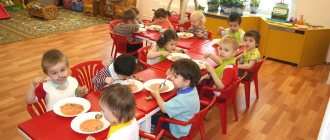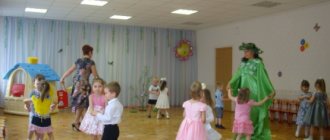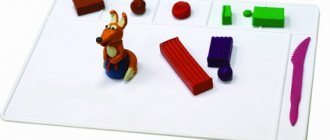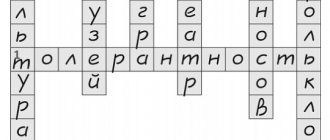Methodological material "" cultural practices in preschool educational institutions
Cultural practices in preschool educational institutions
Yatskova O.A.
municipal budgetary preschool educational institution "Kindergarten No. 316 of a combined type"
Cultural practices
– various types of independent activity, behavior, mental well-being and types of unique individual life experiences that develop from the first days of life, based on the child’s current and future interests.
Cultural practices are situational, autonomous, independent, initiated by an adult or the child himself, the acquisition and repetition of various experiences of communication and interaction with people in various situations, teams, communities and social structures with adults, peers and younger children. It is also the development of positive life experiences of empathy, goodwill and love, friendship, help, care, altruism, as well as negative experiences of dissatisfaction, resentment, jealousy, protest, and rudeness.
The main cultural practices mastered by preschoolers include:
- game (plot and with rules);
- productive activity;
- educational and research activities (experiments, collecting, traveling on the map...);
- reading fiction;
- practical activities (labor education);
- effective physical exercises (“physical education”);
- communication training (speech development);
- playing music
In cultural practices, the educator creates an atmosphere of freedom of choice, creative exchange and self-expression, cooperation between adults and children. The organization of cultural practices is predominantly subgroup in nature.
Social and personal communication
Along with working to form and maintain positive relationships among peers, children should be taught how to build relationships with younger children. By organizing inter-age communication, two problems can be solved:
1. To form a new experience of friendly relations for all participants.
2. Enrich the older children’s self-image with ideas about themselves as a helper and protector of the weak.
The purpose of inter-age communication
– the formation of positive emotions in children of both groups and the creation of an attitude towards such communication as an interesting and pleasant event.
Situations of communication and accumulation of positive socio-emotional experience are problematic in nature and contain a life problem close to preschool children, in the solution of which they are directly involved. Such situations can be of a real-practical nature (providing assistance to children, elders), of a conditionally verbal nature (based on life stories or plots of literary works) and imitative-game ones. In situations of a conditionally verbal nature, the teacher enriches children’s ideas about the experience of resolving certain problems, calls children to an intimate conversation, and connects the content of the conversation with the children’s personal experience. In real-life practical situations, children gain experience in showing a caring, sympathetic attitude towards people, take part in important matters (“We plant seedlings”, “We decorate the kindergarten for the holiday”, “We help the kids get dressed”, etc.)
Situations can be planned by the teacher in advance, or they can arise in response to events that occur in the group and help resolve emerging problems.
Cultural practice is
- These are ordinary, habitual methods and forms of self-determination for a person, norms of behavior and activity.
- These are various types of independent activity, behavior and experience, based on the child’s current and future interests, that develop from the first days of his life.
- These are his usual (habitual, everyday) ways of self-determination and self-realization, closely related to the vital content of his being and events with other people.
- This is the acquisition of one’s own moral and emotional experience of compassion, care, empathy, help, etc.
- This is a spontaneous and sometimes mundane assimilation of various experiences of communication and group interaction with adults, peers and younger children.
The result of the implementation of cultural practices:
Formation of the child’s universal skills: include the child’s readiness and ability to act in all circumstances and life and activities based on cultural norms and express:
Content, quality and direction of his actions and actions.
Individual characteristics (originality and uniqueness) of his actions.
Acceptance and assimilation of the cultural norms of the community to which the child belongs.
Acceptance of universally significant (universal) cultural patterns of activity and behavior.
Types of cultural practices:
- Legal practices.
- Practices of cultural identification.
- Practices of integrity of the physical-mental-spiritual organization of the child’s personality.
- Practices to empower a child.
- Practices of freedom.
Content of cultural practices:
The child independently sees the problem and can determine its content. Actively expresses proposals and ways to solve problems, uses argumentation and evidence in the process of cognitive and research activities.
Cultural practices are organized in the afternoon and are aimed at children demonstrating independence and creativity in various activities. In cultural practices, the educator creates an atmosphere of freedom of choice, creative exchange and self-expression, cooperation between adults and children. The organization of cultural practices is predominantly subgroup in nature.
Options for cultural practices:
1. Joint play between the teacher and children (role-playing, directing, dramatization, construction and construction games) is aimed at enriching the content of creative games and children mastering the gaming skills necessary to organize independent play.
2. Situations of communication and accumulation of positive socio-emotional experience are problematic in nature and contain a life problem that is close to preschool children, in the resolution of which they are directly involved. Such situations can be of a real-practical nature (providing assistance to children, elders), of a conditionally verbal nature (based on life stories or plots of literary works) and imitative-game ones.
In situations of a conditionally verbal nature, the teacher enriches children’s ideas about the experience of resolving certain problems, calls children to an intimate conversation, and connects the content of the conversation with the children’s personal experience. In real-life practical situations, children gain experience in showing a caring, sympathetic attitude towards people, and take part in important matters (“We plant seedlings for flowers,” “We decorate the kindergarten for the holiday,” etc.). Situations can be planned by the teacher in advance, or they can arise in response to events that occur in the group and help resolve emerging problems.
3. The creative workshop provides children with conditions for using and applying knowledge and skills. The workshops are varied in their themes and content, for example: handicrafts, introduction to folk crafts (“Visiting Folk Crafts”), viewing educational presentations, designing an art gallery, book corner or library (“Printing Workshop”, “Visiting a Fairy Tale” ), games and collecting.
The beginning of a workshop is usually a task around a word, melody, drawing, object, memory. This is followed by working with a wide variety of materials: words, sound, color, natural materials, diagrams and models. And it is necessary to include children in reflective activities: analysis of their feelings, thoughts, views (“What were you surprised by? What did you learn? What made you happy?” etc.). The result of work in the creative workshop is the creation of homemade books, children's magazines, drawing up travel routes to nature, designing a collection, creating children's handicraft products, etc.
4. Musical, theatrical and literary living room (children's studio) is a form of organizing artistic and creative activities of children, which involves organizing the perception of musical and literary works, creative activity of children and free communication between the teacher and children on literary or musical material.
5. Sensory and intellectual training - a system of tasks of a predominantly playful nature, ensuring the formation of a system of sensory standards (color, shape, spatial relationships, etc.), methods of intellectual activity (the ability to compare, classify, compile serial series, systematize according to any attribute and etc.). This includes educational games, logic exercises, and entertaining tasks.
6. Children's leisure is a type of activity purposefully organized by adults for play, entertainment, and relaxation. As a rule, the kindergarten organizes leisure activities “Health and outdoor games”, musical and literary leisure activities. It is possible to organize leisure activities in accordance with the interests and preferences of children (in older preschool age). In this case, leisure time is organized as a creative workshop. For example, for handicrafts, artistic work, design, experimentation, etc.
7. Collective and individual labor activity is of a socially useful nature and is organized as household work and work in nature.
Conclusions. Cultural practices are various ways of self-determination and self-realization of a child, based on everyday (ordinary, familiar) and at the same time interesting for him types of independent activity, behavior and experience. The use of cultural practices in modern kindergartens is caused by the need to expand the social and practical components of educational content to enrich the cultural experience of each child, taking into account his individuality. But for the successful implementation of this idea, it is necessary to radically change the view of teachers on culture - the formation of a willingness to see in it the purpose, meaning and main content of education.
LITERATURE
Krylova N.B. Development of the cultural approach in modern pedagogy // Personality in the sociocultural dimension: history and modernity: Collection of articles. articles. M.: Indrik, 2007. pp. 132–138.
Likhachev D.S. Russian culture: Sat. / Comp. L.R. Mariupolskaya. M.: Art, 2000.
Lykova I.A., Protasova, E.Yu. Cultural practices in kindergarten: modern approach and possible interpretations // Scientific and methodological journal “Kindergarten: theory and practice”. 2015. No. 5. P. 6–18.
Lykova I.A. Child and culture: meaningful communication in the language of artistic images, signs and symbols // Pedagogy of Art: electronic scientific journal. URL: https://www.art-education.ru/AE-magazine. — 2013. — No. 2. 1 pp. URL: https://www.art-education.ru/AE-magazine/archive/nomer-2-2013/lykova_2_2013.pdf
Article “Organization of cultural practices of preschool children”
Key words: organization, children, Federal State Educational Standard, practices, play activities. The Federal State Educational Standard for preschool education includes educational guidelines and requirements that are aimed at ensuring a fulfilling life for preschool children and which are satisfied precisely by the organization of gaming activities as a cultural practice. The text of the Federal State Educational Standard for preschool education talks about play activities, and it states that the teacher must provide “wide opportunities for the development of free play for children, including providing a play space, “Involvement of all children in various types of activities and cultural practices that contribute to the development of norms.” social behavior, interests and cognitive actions"
The play activity of preschoolers as a cultural practice, representing an integrative phenomenon, ensures the satisfaction of the current needs of the child and society by focusing on the potential social capabilities of children. This activity as an educational tool “keeps pace” with the times and is focused on the implementation of a cultural approach in preschool education.
Cultural practices include the whole variety of research, socially oriented, communicative, and artistic activities.
Cooperative play
teacher and children (role-playing, directorial, dramatization games, construction games)
Situations of communication and accumulation of positive socio-emotional experience
are problematic in nature and contain a life problem close to preschool children, in the resolution of which they are directly involved.
Creative workshop
provides children with conditions for using and applying knowledge and skills. The workshops are varied in their themes and content, for example, handicrafts, familiarization with folk crafts (“Visiting Folk Crafts”), viewing educational presentations, designing an art gallery, book corner or library (“Printing Workshop”, “Visiting a Fairy Tale” "), games and collecting.
Musical, theatrical and literary living room (children's studio)
- a form of organizing artistic and creative activity of children, which involves organizing the perception of musical and literary works, creative activity of children and free communication between the teacher and children on literary or musical material.
Sensory and intellectual training
– a system of tasks, predominantly of a gaming nature, ensuring the formation of a system of sensory standards (color, shape, spatial relationships, etc.), This includes educational games, logical exercises, and entertaining tasks.
Children's leisure
- a type of activity purposefully organized by adults for play, entertainment, and relaxation. Sometimes leisure time is organized as a “circle”. For example, for handicrafts, artistic work, etc.
Collective and individual labor activity
is of a socially useful nature and is organized as household labor and labor in nature.
cultural practices are predominantly subgroup in nature.
In order for upbringing and learning to become effective, it is necessary to simultaneously create conditions for the deployment of a system of diverse free practices of the child, which ensure his independent, responsible self-expression. If they are provided, then traditional methods (influences) begin to transform into methods of interaction. With a developed system of cultural practices, a child needs not so much upbringing as pedagogical support, cooperation, the general mental attitude (care) of an adult and a child, their mutual trust, concern for a common cause (interest).
Cultural practices are a concept that explains how a child becomes the subject of an active attitude, perception, choice, test of strength, acceptance or non-acceptance of something in his life. This concept helps explain through what cultural mechanisms a child chooses this or that action and what impact this choice has on development. Cultural practices are situational, autonomous, independent, initiated by an adult or the child himself, the acquisition and repetition of various experiences of communication and interaction with people in various groups, teams, communities and social structures with adults, peers and younger children. It is also the development of positive life experiences of empathy, goodwill and love, friendship, help, care, altruism, as well as negative experiences of dissatisfaction, resentment, jealousy, protest, and rudeness. What exactly a child will practice depends on his character, value system, lifestyle, and future fate.
He begins to practice these types of activities and behaviors as interesting to him and providing self-realization. So N.B. Krylova in her works uses the phrase “game practice”, and considers the game as one of the various cultural practices. For a preschool child, this cultural practice is one of the leading ones.
The art of a teacher lies in organizing the educational process in such a way that the child himself wants to learn, learn or do something. And the “Situation” technology helps the teacher with this. The essence of this technology is to organize developmental situations with children, based on the use of general cultural knowledge about the laws of effective activity, taking into account the age characteristics of preschoolers. Hence the name of the technology – “Situation”, since it is based on the various situations that children encounter during the day. The “Situation” technology gives the teacher the opportunity to manage the situation that has arisen in such a way as to help the child take an independent step in understanding the world; gain experience in performing universal actions to identify difficulties, identify their causes, set goals, plan your actions, correlate the set goal with the result obtained, etc.
The Federal State Educational Standard for preschool education includes educational guidelines and requirements that are aimed at ensuring a fulfilling life for preschool children and which are satisfied precisely by the organization of gaming activities as a cultural practice. The text of the Federal State Educational Standard for preschool education talks about play activities, and it states that the teacher must provide “wide opportunities for the development of free play for children, including providing a play space, “involving all children in different types of activities and cultural practices that contribute to the development of norms.” social behavior, interests and cognitive actions" Playing activity of preschool children as a cultural practice, representing an integrative phenomenon, ensures the satisfaction of the current needs of the child and society by focusing on the potential social capabilities of children. This activity as an educational tool “keeps pace” with the times and is focused on the implementation of a cultural approach in preschool education.
These types of cultural practices are proposed by the authors and the Program itself.
For children: children understand the symbols depicted on the coat of arms and flag. Children will learn that the anthem is the main song for all the people of the Russian Federation.
For the educator: in the course of cultural practice, the tasks of the section “Cognition,
Also, during cultural practice, children show curiosity, ask questions to adults and peers, and try to independently come up with explanations for questions that arise. Children learn to make their own decisions, relying on their knowledge and skills in various activities. And, most importantly, children master oral speech well and can express their thoughts and desires. Thus, with the help of cultural practices, we implement targets at the stage of completion of the Federal State Educational Standard for Education.
Thus, we can conclude that it is advisable to use cultural practices in amplifying child development. For an adult, there is another opportunity to come into contact with the wonderful world of childhood and become a close friend for the child.
Plot-role-playing game as a cultural practice in the context of the implementation of the Federal State Educational Standard for Education
Tasks:
To analyze the psychological and pedagogical literature on the problem of the development of role-playing games as a cultural practice in preschool age.
Enrich the RPPS to provide role-playing games in the middle group of kindergarten
Provide pedagogical guidance for role-playing games, taking into account the interests and needs of children
To achieve this goal and objectives, I studied methodological manuals on organizing a role-playing game. In the manual N.F. Gubanova “Development of play activities”, recommended by the authors of the comprehensive program “From birth to school”, provides a system of work in the middle group of a kindergarten on organizing play activities, as well as an approximate topic of role-playing games-situations that children of the fifth year of life can master. In the methodological manual Mikhailenko N.Ya., Korotkova N.A. “Organizing a story-based game in a kindergarten” proposes a new approach to organizing a story-based game in a kindergarten, aimed at activating the free independent play of children by imparting to them gradually more complex gaming skills.
To ensure the play activity of children aged 4-5 years, I analyzed the developing subject-spatial environment in the group and found that the group did not have enough attributes and play material for the development of role-playing games. To solve this problem, I developed a plan for enriching RPPS in the group in accordance with the requirements of the Federal State Educational Standard. During the school year, game aids and attributes for the games were made and purchased: “Family”, “Transport”, “Hospital”, “Shop”, “Workshop”, “Hairdresser”, “Post Office”, “Kindergarten”. Algorithms were developed for each game. The gaming environment has been replenished with costumes - these are robes, capes, hats, and accessories. For the game “Transport”, covers were sewn for various vehicles: ambulance, police, fire, etc. To ensure the principle of transformability and multifunctionality, covers for screens were sewn, which can change depending on the situation and theme of the game. Many attributes were made with our own hands and with the help of parents, for example, food products were made for the games “Shop” and “Family”: sewn from fabric, knitted, made from waste material. The subject-game environment was equipped taking into account a gender approach: for example, albums were made with hairstyles and clothes for boys and girls, costumes and hats, jewelry for girls, knightly armor for boys and more. An important point in the development of play in children is the introduction of substitute objects. For this purpose, I made a chest containing parts from old construction sets, cubes, ropes, scraps, cones, boxes, unbreakable bubbles, etc. And so that children could use these items in the game, I developed an album of hints.





